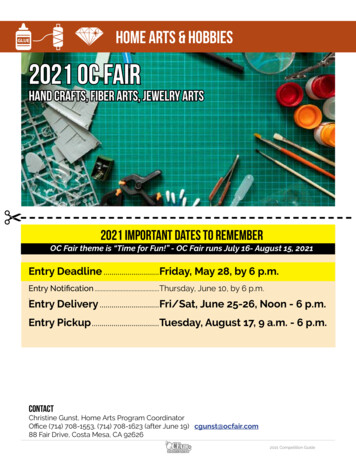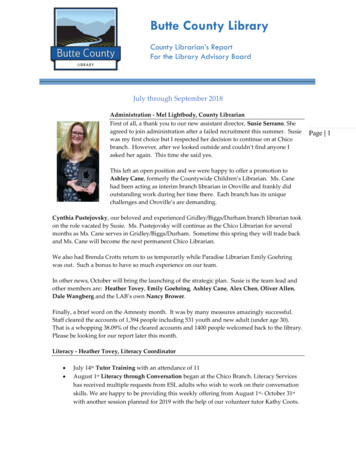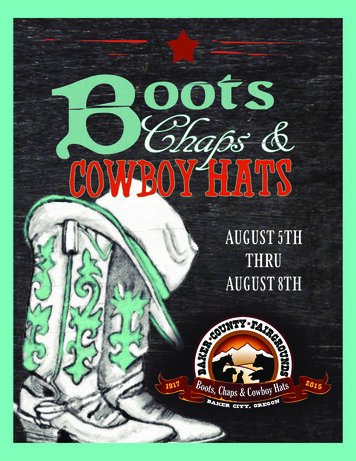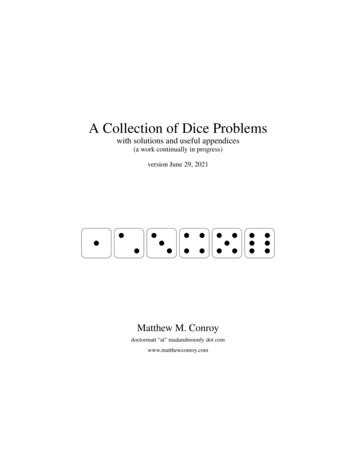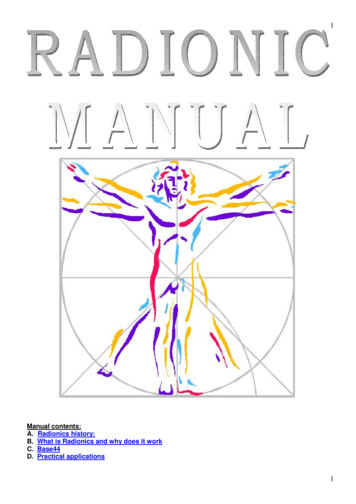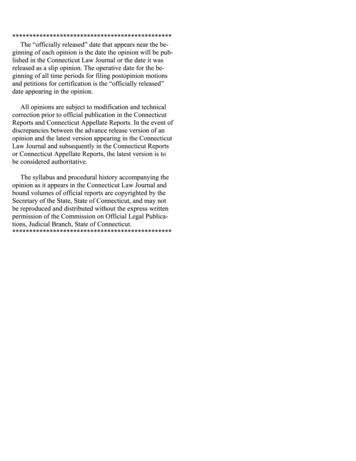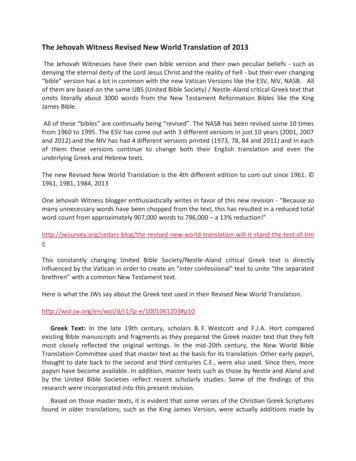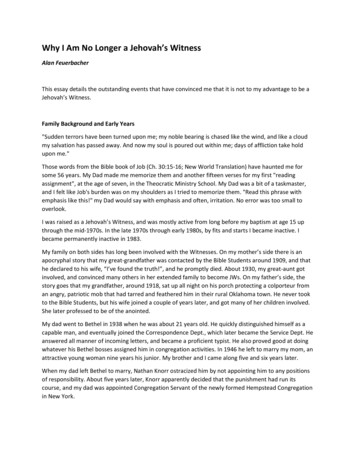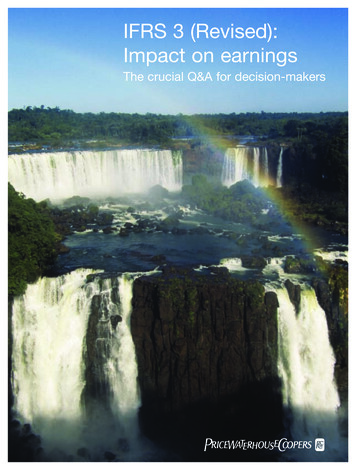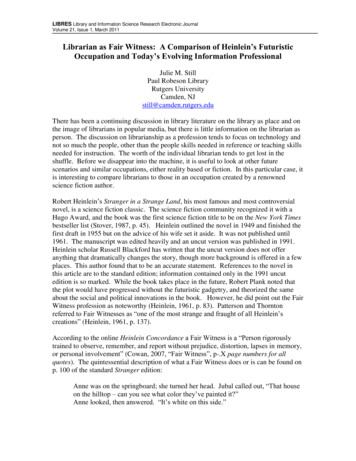
Transcription
LIBRES Library and Information Science Research Electronic JournalVolume 21, Issue 1, March 2011Librarian as Fair Witness: A Comparison of Heinlein’s FuturisticOccupation and Today’s Evolving Information ProfessionalJulie M. StillPaul Robeson LibraryRutgers UniversityCamden, NJstill@camden.rutgers.eduThere has been a continuing discussion in library literature on the library as place and onthe image of librarians in popular media, but there is little information on the librarian asperson. The discussion on librarianship as a profession tends to focus on technology andnot so much the people, other than the people skills needed in reference or teaching skillsneeded for instruction. The worth of the individual librarian tends to get lost in theshuffle. Before we disappear into the machine, it is useful to look at other futurescenarios and similar occupations, either reality based or fiction. In this particular case, itis interesting to compare librarians to those in an occupation created by a renownedscience fiction author.Robert Heinlein’s Stranger in a Strange Land, his most famous and most controversialnovel, is a science fiction classic. The science fiction community recognized it with aHugo Award, and the book was the first science fiction title to be on the New York Timesbestseller list (Stover, 1987, p. 45). Heinlein outlined the novel in 1949 and finished thefirst draft in 1955 but on the advice of his wife set it aside. It was not published until1961. The manuscript was edited heavily and an uncut version was published in 1991.Heinlein scholar Russell Blackford has written that the uncut version does not offeranything that dramatically changes the story, though more background is offered in a fewplaces. This author found that to be an accurate statement. References to the novel inthis article are to the standard edition; information contained only in the 1991 uncutedition is so marked. While the book takes place in the future, Robert Plank noted thatthe plot would have progressed without the futuristic gadgetry, and theorized the sameabout the social and political innovations in the book. However, he did point out the FairWitness profession as noteworthy (Heinlein, 1961, p. 83). Patterson and Thorntonreferred to Fair Witnesses as “one of the most strange and fraught of all Heinlein’screations” (Heinlein, 1961, p. 137).According to the online Heinlein Concordance a Fair Witness is a “Person rigorouslytrained to observe, remember, and report without prejudice, distortion, lapses in memory,or personal involvement” (Cowan, 2007, “Fair Witness”, p-.X page numbers for allquotes). The quintessential description of what a Fair Witness does or is can be found onp. 100 of the standard Stranger edition:Anne was on the springboard; she turned her head. Jubal called out, “That houseon the hilltop – can you see what color they’ve painted it?”Anne looked, then answered. “It’s white on this side.”
Jubal went on to Jill, “You see? It doesn’t occur to Anne to infer that the otherside is white, too. All the King’s horses couldn’t force her to commit herself unless she went there and looked – and even then she wouldn’t assume that itstayed white after she left.”Another example is given on p. 114:“Hell’s bells, you wouldn’t testify that the sun had risen if the day was cloudy.”“How could I? Somebody might be supplying artificial light above the cloudlayer.”Fair Witnesses work on a strictly empirical basis resolutely refusing to make assumptionsor to allow their thoughts to fill in the blanks in reasoning or visual images. They striveto see what is there without the filters of expectation or social convention.Fair Witnesses appear in only one of Heinlein’s works, the aforementioned Stranger in aStrange Land, and there is no information on the origin of the profession in publishedworks on Heinlein or in his letters. Fair Witnesses are not examined in the literarycriticism of the novel.In fact, in a review of several standard academic databases, such as the MLAInternational Bibliography, Library Literature, and the Humanities Index, the onlyarticle found on the characters is “Transversality and the Role of the Library as FairWitness,” by Ross Atkinson, published in the 2005 Library Quarterly. Atkinson focusedon the impartiality of Fair Witnesses as a model for libraries as a trusted third party, or, ashe states, “safeguarding the validity of the text” (p. 172). Even here, though, thelibrarian is merely a part of the library, an object within a building. He states “In thenovel, therefore, there are designated individuals whose professional role in society is tobe trustworthy” (p. 178). However, the crux of his article is that the library, theinstitution, is the Fair Witness. “The library as fair witness would itself aim to make noqualitative judgment about the value or utility of any object but would rather supplyaccess to a range of discrete information sources that permit the user to draw suchconclusions” p. 179 ).While Atkinson focuses on the role of the library itself, the institution, the physical place,as a Fair Witness, perhaps it would also be appropriate to look at the role of the librarianas person, and librarianship as a profession, as analogous to the profession of FairWitness. At the time Heinlein was writing Stranger the common definition of aprofession, as reflected in two standard social science reference works (Parsons, 1968;and Waddington, 1996) was an occupation that requires some level of education orcertification, with an association relating to that profession, a code of ethics prepared forand by practitioners, and altruistic service or a sense of social responsibility. If we acceptthat definition, then we can compare those aspects of librarianship and Fair Witness.Fair Witnesses are a recognized profession, or a guild as they are referred to in the book,and at least one training school or college, the Rhine Foundation, is mentioned. They arePg 2LIBRES ISSN 1058-6768 Volume 21, Issue 1, March 2011
taught memorization. A professional publication, Witness Quarterly, is also mentioned.Fair Witnesses have a professional uniform, a white robe. When robed they are notconsidered invisible but are not introduced or spoken to while observing in a professionalcapacity. Nor are people likely to jostle them or intrude upon their space. Some arecertified to present evidence in the High Court. Their services are for hire and a wellrespected Fair Witness can command a high salary.When unrobed and in street clothes they can, unless otherwise constrained, provideopinions on topics relating to professional queries to their employer or others if allowedby contract. Many of these features correspond to aspects of librarianship. Librariansstudy towards and receive graduate degrees in library science or some variation thereof(information science, for example), the profession has one standard association, theAmerican Library Association, with a hierarchy of task and subject oriented subassociations, and the field has a number of professional journals.We may compare the two by analyzing, in addition to basic job functions, their ethics andthe types of people drawn to both professions.The American Library Association’s Code of Ethics (ALA, 2008) reads:I.II.III.IV.V.VI.VII.VIII.We provide the highest level of service to all library users through appropriateand usefully organized resources; equitable service policies; equitable access; andaccurate, unbiased, and courteous responses to all requests.We uphold the principles of intellectual freedom and resist all efforts to censorlibrary resources.We protect each library user's right to privacy and confidentiality with respect toinformation sought or received and resources consulted, borrowed, acquired ortransmitted.We respect intellectual property rights and advocate balance between the interestsof information users and rights holders.We treat co-workers and other colleagues with respect, fairness, and good faith,and advocate conditions of employment that safeguard the rights and welfare ofall employees of our institutions.We do not advance private interests at the expense of library users, colleagues, orour employing institutions.We distinguish between our personal convictions and professional duties and donot allow our personal beliefs to interfere with fair representation of the aims ofour institutions or the provision of access to their information resources.We strive for excellence in the profession by maintaining and enhancing our ownknowledge and skills, by encouraging the professional development of coworkers, and by fostering the aspirations of potential members of the profession.While many professions include confidentiality in their ethical guidelines, such asdoctors, lawyers, and financial professionals, there are additional rules for librarians thatdovetail with the Fair Witnesses.Pg 3LIBRES ISSN 1058-6768 Volume 21, Issue 1, March 2011
Looking at the first and third of the eight tenants in the Code of Ethics, that service willbe equitable, accurate, and unbiased, and that a user’s right to privacy and confidentialitywill be protected, we find passages that show the same ethical requirements of FairWitnesses. In the passage below, wherein Jubal Harshaw explains to Gillian Boardmanwhat a Fair Witness is, note that information is provided in an unbiased manner, and thatthose observations can be made public or kept private:“Anne is a Fair Witness?”“Graduate, unlimited license, admitted to testify before the High Court.Sometime ask her why she gave up public practice. But don’t plan anything elsethat day – the wench will recite the whole truth and nothing but the truth, whichtakes time. Back to Mr. Cavendish – Ben retained him for open witnessing, fulldisclosure, without enjoining privacy. So when Cavendish was questioned, heanswered, in boring detail. The interesting part is what he does not say. He neverstates that the man they saw was not the Man from Mars but not one wordindicates that Cavendish accepted the exhibit as being the Man from Mars. If youknew Cavendish, this would be conclusive. If Cavendish had seen Mike, hewould have reported with such exactness that you and I would know that he hadseen Mike. For example, Cavendish reports the shape of this exhibit’s ears andit does not match Mike’s ears. Q.E.D.; they were shown a phony. Cavendishknows it, though he is professionally restrained from giving opinions.” (Heinlein,1961, p. 100)Points two and four of the ALA Code of Ethics refer intellectual freedom and protectionof intellectual property. When someone asks Jubal Harshaw if he is presenting the realman from Mars or a fake, Harshaw replies “Would I swindle you with a Fair Witness atmy elbow?” (Heinlein, 1961, p. 174). Even though the Fair Witness in question is inHarshaw’s employ, he is saying her occupational integrity would not allow her to goalong with a deception. While the man from Mars is not intellectual property per se,presenting someone who was not him as the real thing would be, in a sense, intellectualforgery, and a Fair Witness would not be a party to it. Both professions are expected tobe fair and balanced, regardless of who is paying the bills.The sixth and seventh points in the ALA Code of Ethics, similar to the first and third,reflect a belief in objectivity and differentiate between personal convictions andprofessional duties, which align with the information presented in this conversation fromStranger between James Oliver Cavendish, a Fair Witness, and Ben Caxton, the man whohas hired him.“Mr. Cavendish, did you see anything that convinced you this bloke was the Manfrom Mars?”Cavendish answered, “It is not my function to form opinions. I see, I hear – thatis all.”“Sorry.”“Are you through with me in my professional capacity?”“Huh? Oh, sure. Thanks, Mr. Cavendish.”Pg 4LIBRES ISSN 1058-6768 Volume 21, Issue 1, March 2011
“Thank you, sir. An interesting assignment.” The old gentleman took off thecloak that set him apart from mere mortals. He relaxed and his featuresmellowed.“If I have been able to bring along a crew member of the Champion,” Caxtonpersisted, “I could have tied it down.”“I must admit,” remarked Cavendish, “that I was surprised at one thing you didnot do.”“Huh? What did I miss?”“Calluses.”“Calluses?”“Surely. A man’s history can be read from his calluses. I once did a monographon them for the Witness Quarterly. This young man from Mars, since he hasnever worn our sort of shoes and has lived in gravity about one third of ours,should display foot calluses consonant with his former environment.”“Damn! Mr. Cavendish, why didn’t you suggest it?”“Sir?” The old man drew himself up and his nostrils dilated. I am a Fair Witness,sir. Not a participant.”“Sorry.” Caxton frowned. “Let’s go back. We’ll look at his feet – or I’ll bust theplace down!”“You will have to find another Witness in view of my indiscretion indiscussing it.” (Heinlein, 1961, pp. 49-50)There are also at least two references to Fair Witnesses behaving differently while robedand on duty. In addition to the note above that Cavendish relaxes after taking off hiscloak, in Heinlein, 1961, p. 150 we find this passage:Anne was standing nearby, dressed in the long white garment she had had withher all day. Smith could not fully grok her mood; he felt in her the coldunyielding discipline of an Old One. It started him, as Anne was always soft andgentle and warmly friendly.On the 8th point of the Code of Ethics, training and professionalism we find this on p. 44:While any Fair Witness would do, the prestige of Cavendish was such that alawyer was hardly necessary – the old gentleman had testified many times beforethe High Court and it was said that the wills locked up in his head representedbillions. Cavendish received his training in total recall from the great Dr. SamuelRenshaw and his hypnotic instruction as a fellow of the Rhine Foundation. Hisfee for a day was more than Ben made in a week, but Ben expected to charge it tothe Post syndicate – the best was none too good for this job.There is the aforementioned reference to a professional publication, The WitnessQuarterly (Heinlein, 1961, p. 49). In the 1991 edition, Fair Witness Cavendish says hisprofessional association would suspend him for unethical behavior (Heinlein, 1991, p.71), implying that Fair Witnesses also had a code of professional ethics.Pg 5LIBRES ISSN 1058-6768 Volume 21, Issue 1, March 2011
Thus, like Fair Witnesses, librarians, while on the job, should not let their own personalopinions on things interfere with their work. While Atkinson (2005) applies this qualityto libraries, a building including its contents and staff, Heinlein applies it to individuals,trained professionals, but operating solely or as part of a firm. As alluded to in onedescription of Anne, some Fair Witnesses worked on the public payroll, particularly incourts.There are of course some differences. Librarians, especially those who work with thepublic, are expected to be open and approachable, though there are still some remnants ofa stereotype of them being stern and intimidating. Fair Witnesses had near total recalland some scientific ability, as noted in these passages:So either a Fair Witness misremembered a cab’s number or somebody tamperedwith the record.” He added, “Maybe a jury would decide that even a Fair Witnesscould misread a number, especially if he had not been asked to remember it – butI don’t believe it – not when the Witness is James Oliver Cavendish. He wouldeither be certain – or his report would never mention it.” (Heinlein, 1961, p. 101)And later, on p. 269:Jubal would have bet his life that if Anne were to witness the Second Coming, shewould memorize date, time, personae, events, and barometric pressure withoutbatting her calm blue eyes.Fair Witnesses share a number of qualities with librarians. Both are analytical. Both arerequired to be objective, at least while on duty. Both strive for accuracy. While theHeinlein Concordance doesn’t mention this, Fair Witnesses, like librarians, serve in aconfidential capacity, unless that is waived by the client. Unlike librarians, FairWitnesses serve some of the functions we think of as being associated with lawyers, suchas remembering (to be recited later) wills; something that would probably now be donedigitally.However, the two professions may share a social function – that of preserving sharedknowledge and culture. As Patterson & Thornton say:The Fair Witness as a highly respected social institution functions to impose thehuman dimension on bourgeois-secular culture and by “continuous recreation” ofimportant commercial facts – wills and contracts are specifically mentioned –bring what Mircea Eliade calls “a timeless present” – the timelessness of thespiritual eternal – back into human affairs (Patterson & Thornton, 2001, p. 137).Fair Witnesses are, to some degree, living libraries and archives. As libraries andlibrarians become more involved in creation and maintenance of digital projects, theyalso become more enmeshed in the continuous recreation of a timeless present.Pg 6LIBRES ISSN 1058-6768 Volume 21, Issue 1, March 2011
Looking at some of the personality characteristics of Fair Witnesses, and comparing themto those of librarians, we see similarities. As has been mentioned, Fair Witnesses, whenrobed, were not introduced or acknowledged, nor did they speak outside of professionalduties; they kept themselves apart, and appear to work individually with clients asopposed to working in groups. This is not the behavior of extremely social people. InDiscovering Librarians (Scherdin, 1994), the notes on librarians as compared to thegeneral population show that while 65% of the general population are extroverts and 35%introverts, it is almost exactly opposite for librarians, 63% introverts and 37% extroverts(Scherdin, 1994, p. 132). Further, the Myers Briggs Type Indicators (MBTI) dividespersonalities into 16 combinations of four personality trait continuums. Librarianspredominantly fall into categories that are not as representative of the general population.For example 17% of librarians tested were placed in the ISTJ category (as opposed to 7%of the general population), and 12% were INTJ (as opposed to 3%). That puts almost onethird of the librarians into those two categories, which represent only a tenth of thepopular at large. Librarians are not represented in any of the other 14 MBTI categories ina number larger than 10%. (Scherdin, 1994, 133). ISTJs are described in part as“practical, orderly, matter-of-fact, logical, realistic, and dependable” (Scherdin, 1994, p.129) and INTJs as “skeptical, critical, independent, determined, sometimes stubborn”(Scherdin, 1994, p. 130). Williamson, Pemberton & Loundsbury (2005) in writing onthe personality traits of librarians noted that “Both types shared the characteristics ofbeing logical, productive, and reflective” (p. 127). These are also qualities that might beused to describe Fair Witnesses, at least while they were robed.It should be noted that Heinlein himself did not make any connection between the twoprofessions, and in fact, though he would speak to librarians’ groups at a time when hewould not to other groups unless they paid his travel and an honorarium (Heinlein, 1989,p. 90), his relationship with librarians was not always cordial. His wife wrote thatanother of his novels, Red Planet, had to be edited to suit the sensibilities of librarians,who were described as “mostly elderly ladies” (Heinlein, 1989, p. 57). In 1954, LearnedT. Bulman requested changes be made in The Star Beast or it would be given a badreview in Library Journal (Heinlein, 1989, p. 70).Yet, as information resources become decoupled from physical buildings and move intothe ether, librarians must leave the building as well. Providing reference service over avariety of electronic formats moves traditional services into a new environment, but otherthan the incorporation of technology, there have been few dramatic shifts in theprofession, and very few librarians are in private practice. Certainly very few, if any, arehired by individuals to do short-term contract duty. Information brokers are oneexception, although very few people work in that field. The Association of IndependentInformation Professionals represents only 500 business owners world-wide. However,should there be a shift in that direction, Heinlein’s Fair Witnesses may provide aninteresting inspiration. At some point librarians may work, not in libraries, but in firms,like attorneys, or in private practice, hired to do short-term or long-term contract work, asJames Oliver Cavendish did, or to act as a librarian for one person over a long period oftime, as Anne did for Jubal Harshaw. The expertise and objectivity of Fair Witnesses,melded with the friendliness and approachability characteristic of the best librarians, andPg 7LIBRES ISSN 1058-6768 Volume 21, Issue 1, March 2011
including the accuracy, ethics, and high standards of both professions, might create somevery intriguing job possibilities.ReferencesAmerican Library Association. (2008). Code of Ethics. Retrieved June 7, 2010 cs/codeofethics/codeethics.cfmAssociation of Independent Information Professionals. Retrieved June 7,2010 from:http://www.aiip.org/Atkinson, R. (2005). Transversality and the role of the library as fair witness. LibraryQuarterly 75(2), 169-89.Blackford, R. (1990). Neo-Bible and ur-text. Foundation: the review of science fiction53, 70-80.Cowan, M. E. (2007). A Heinlein concordance. Retrieved June 7, 2010 dex.htmHeinlein, R. A. (1961, 1987 printing). Stranger in a strange land. New York, USA:Ace Books.Heinlein, R. A. (1989). Grumbles from the grave. (ed. Virginia Heinlein). New York,USA: Ballantine.Heinlein, R. A. (1991). Stranger in a strange land: The original uncut version. NewYork, USA: Ace Books.Parson, T. (1968) Professions, In D.L. Sills (Ed.). International Encyclopedia of theSocial Sciences, v. 12 ( pp. 536-547) New York, USA: Macmillan.Patterson, W. H., Jr. & Thornton, A. (2001). Critical perspectives on Robert A.Heinlein’s stranger in a strange land. Sacramento, USA: Nitrosyncretic Press.Plank, R., (1978). Omnipotent cannibals in “stranger in a strange land. In J. D. Olander& M. H. Greenberg (Eds.). Robert Heinlein (pp. 83-106). New York, USA: TaplingerPublishing Co.Scherdin, M. J. (1994). Vive la difference: Exploring librarian personality types usingthe MBTI. In M. J. Scherdin (Ed.). Discovering librarians: Profiles of a profession (pp.125-156). Chicago, USA: American Library Association.Stover, L. (1987). Robert A. Heinlein. Boston, USA: Twayne.Pg 8LIBRES ISSN 1058-6768 Volume 21, Issue 1, March 2011
Waddington, I. (1996). Professions In A. Kuper,& J. Kuper (Eds.). The Social ScienceEncyclopedia, 2nd ed. (pp. 677-678) New York, USA: Routledge.Williamson, J. M., Pemberton, A. E., & Lounsbury, J. W. (2005). An investigation ofcareer and job satisfaction in relation to personality traits of information professionals.Library Quarterly 75(3), 122-141.Pg 9LIBRES ISSN 1058-6768 Volume 21, Issue 1, March 2011
According to the online Heinlein Concordance a Fair Witness is a “Person rigorously trained to observe, remember, and report without prejudice, distortion, lapses in memory, or personal involvement” (Cowan, 2007, “Fair Witness”, p-.X page numbers for all quotes). The quintessential
